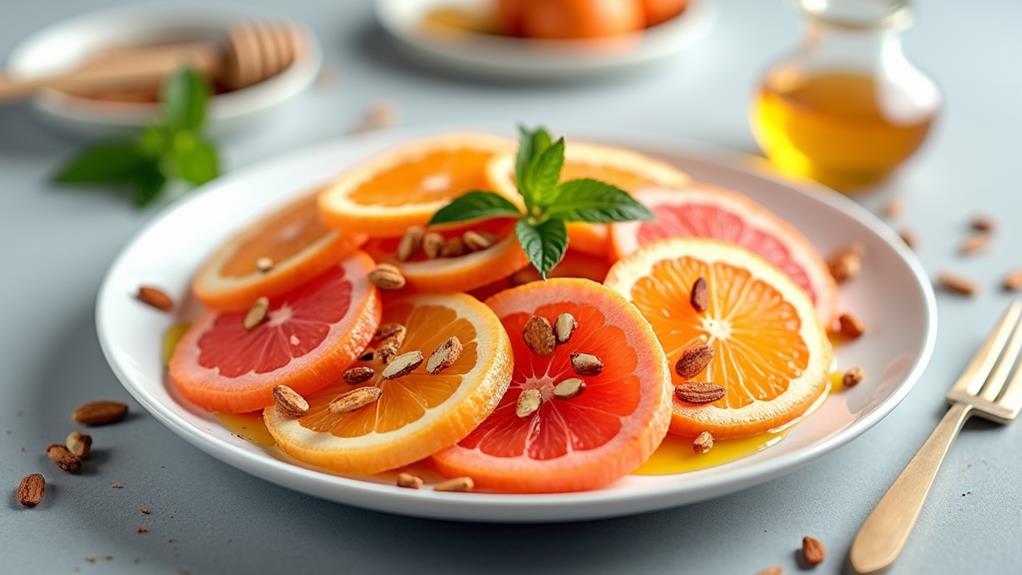You've likely encountered winter citrus salads before, but you might not have realized their full potential. These vibrant dishes aren't just a feast for the eyes; they're a burst of sunshine on your plate during the coldest months. With their perfect balance of sweet and tart flavors, winter citrus salads offer a refreshing counterpoint to heavy seasonal fare. But there's more to these colorful creations than meets the eye. From their intriguing history to the nuances of crafting the perfect dressing, winter citrus salads have secrets waiting to be uncovered. So, what makes this seemingly simple dish so special?
Key Takeaways
- Winter Citrus Salad features seasonal fruits like oranges and grapefruit, showcasing vibrant colors and refreshing flavors.
- The dish requires only five ingredients: oranges, grapefruit, olive oil, honey, and sliced almonds.
- Preparation involves segmenting citrus fruits, creating a honey-olive oil dressing, and garnishing with toasted almonds and mint.
- The salad offers nutritional benefits, including high vitamin C content and antioxidants from fresh citrus fruits.
- It's versatile, serving as a light lunch, side dish, or palate-cleansing dessert in various meal contexts.
History
The origins of citrus salads can be traced back to ancient Mediterranean cultures. These early civilizations recognized the nutritional value and refreshing taste of citrus fruits, often combining them with local ingredients to create simple yet flavorful dishes.
As trade routes expanded, citrus fruits spread across the globe, leading to the development of diverse salad variations in different regions.
You'll find that the modern Winter Citrus Salad has evolved from these historical roots, incorporating contemporary culinary techniques and flavor combinations.
In the 19th and 20th centuries, as citrus fruits became more widely available, chefs and home cooks began experimenting with new ways to showcase their vibrant colors and tangy flavors. The addition of dressings, nuts, and other complementary ingredients has transformed the simple citrus salad into a more complex and satisfying dish.
Today, you can enjoy Winter Citrus Salad as a refreshing counterpoint to heavier winter fare.
It's a testament to the enduring appeal of citrus fruits and their ability to brighten up even the coldest months of the year.
Recipe
Winter Citrus Salad is a refreshing and vibrant dish that brings a burst of sunshine to the colder months. This simple yet elegant salad showcases the best of seasonal citrus fruits, combining their juicy sweetness with a hint of savory complexity.
With just five ingredients, this recipe is easy to prepare and perfect for a light lunch or as a side dish for dinner. The contrast of colors and flavors makes it visually appealing and delightful to the palate, offering a healthy dose of vitamin C and antioxidants.
- 2 large oranges (about 1 lb or 450g)
- 1 large grapefruit (about 12 oz or 340g)
- 1/4 cup (60ml) extra-virgin olive oil
- 2 tablespoons (30ml) honey
- 1/4 cup (30g) sliced almonds
To prepare the Winter Citrus Salad, start by peeling the oranges and grapefruit, making sure to remove all the white pith. Slice the fruit into thin rounds and arrange them on a serving platter.
In a small bowl, whisk together the olive oil and honey until well combined. Drizzle this dressing over the citrus slices. Toast the sliced almonds in a dry pan over medium heat until golden brown, then sprinkle them over the salad just before serving.
For best results, choose ripe, juicy citrus fruits that are heavy for their size. You can prepare the citrus slices and dressing ahead of time, but don't assemble the salad until just before serving to keep the fruits fresh and prevent them from releasing too much juice.
Feel free to experiment with different types of citrus, such as blood oranges or tangerines, to add variety to the salad.
Cooking Steps
You'll begin by peeling and segmenting the citrus fruits, ensuring all white pith is removed for a clean, sweet taste.
Next, you'll prepare a simple honey-olive oil dressing and arrange the fruit segments on a platter, creating an eye-catching display.
Step 1. Peel and Segment Citrus
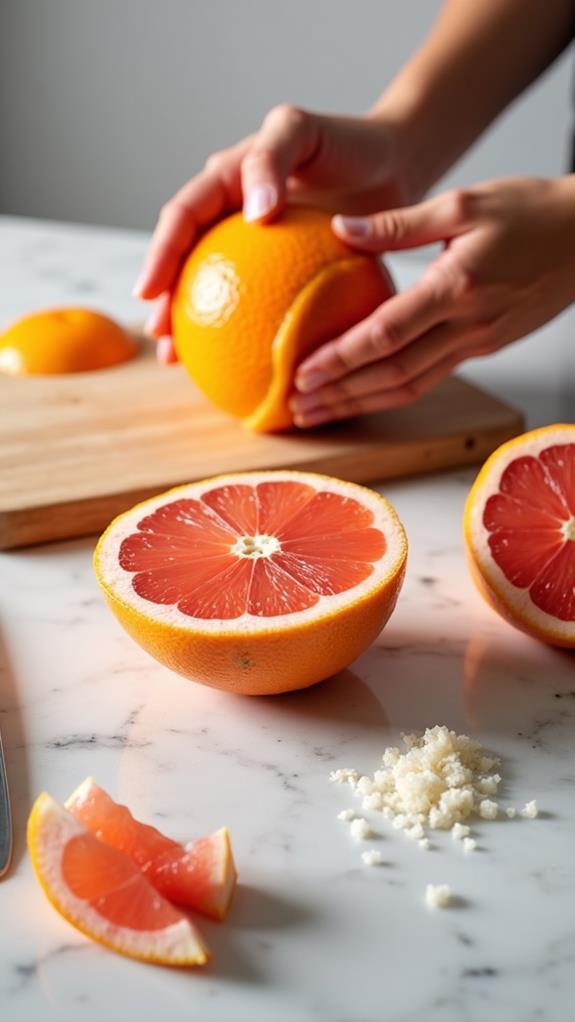
To peel and segment citrus fruits for your Winter Citrus Salad, start by washing the oranges and grapefruit thoroughly under cool running water. Pat them dry with a clean kitchen towel.
Next, place a fruit on a cutting board and, using a sharp knife, slice off the top and bottom to create flat surfaces. Stand the fruit upright and, following its natural curve, cut away the peel and white pith in strips from top to bottom.
Rotate the fruit as you go to ensure you remove all the outer skin and bitter pith. Once peeled, hold the fruit over a bowl to catch any juice.
Carefully slice between the membranes to release the segments, letting them fall into the bowl. You'll want to work your way around the entire fruit, separating each segment. Don't forget to squeeze the remaining membrane to extract any leftover juice.
Repeat this process for all your citrus fruits. If you prefer, you can slice the peeled fruits into rounds instead of segmenting them. This method works well for presentation and allows for a different texture in your salad.
Step 2. Prepare Honey-Olive Oil Dressing
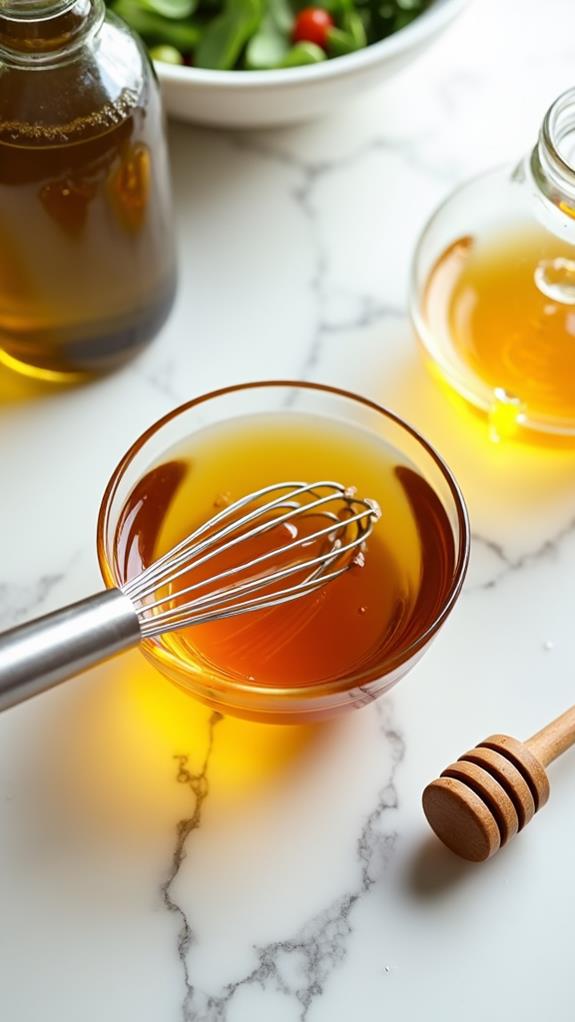
Creating the honey-olive oil dressing for your Winter Citrus Salad is a simple yet crucial step. You'll need a small bowl, a whisk, and just two ingredients: extra-virgin olive oil and honey.
Start by measuring out 1/4 cup of olive oil and 2 tablespoons of honey. Pour both into your bowl, ensuring you've scraped all the honey from the measuring spoon.
Now, it's time to whisk. Hold the bowl steady with one hand and vigorously whisk with the other, moving in a circular motion. You're aiming to fully incorporate the honey into the oil, which may take a minute or two. As you whisk, you'll notice the mixture becoming slightly thicker and more uniform in color.
Don't worry if it doesn't emulsify completely; a slight separation is normal.
Once you've achieved a well-blended dressing, give it a taste. If you prefer it sweeter, add a touch more honey. For a more savory profile, a pinch of salt can balance the flavors.
Step 3. Arrange Fruit on Platter
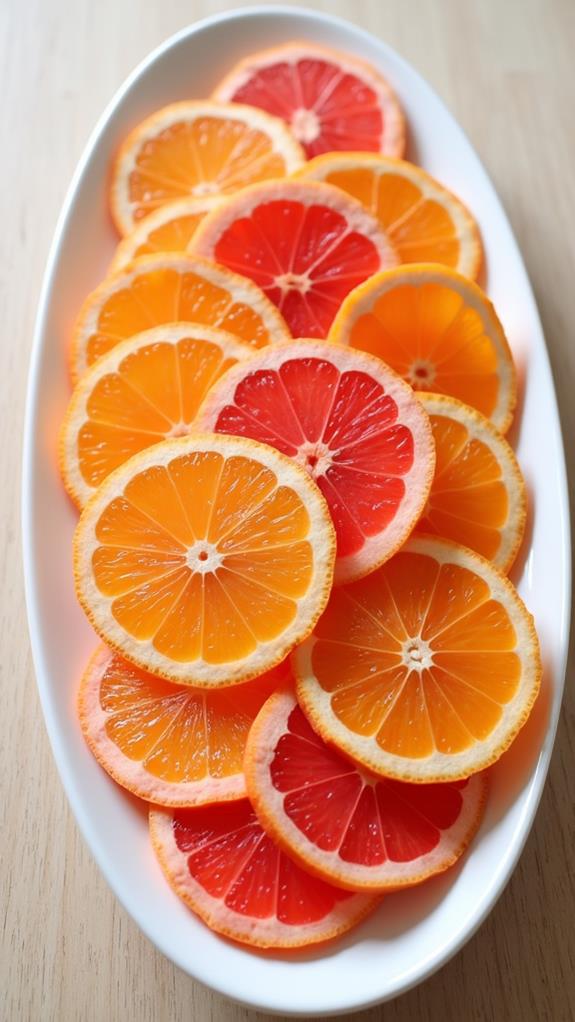
Once you've prepared your citrus fruits, it's time to arrange them on the platter. Begin by selecting a large, flat serving dish that will comfortably accommodate all your citrus slices.
Start with a layer of orange rounds, slightly overlapping them to create a visually appealing base. Next, add a layer of grapefruit slices, positioning them to contrast with the oranges and create an interesting pattern.
Continue alternating between orange and grapefruit slices, building up layers and ensuring that each type of fruit is evenly distributed across the platter.
As you arrange the fruits, pay attention to color variation, mixing lighter and darker hues to create a vibrant display. Don't be afraid to slightly tilt or angle some slices to add depth and dimension to your presentation.
If you're using different citrus varieties, such as blood oranges or tangerines, incorporate them strategically to add pops of color throughout the arrangement.
Once you're satisfied with the layout, step back and assess the overall composition, making any final adjustments to ensure a balanced and attractive display that will entice your guests.
Step 4. Toast and Add Almonds
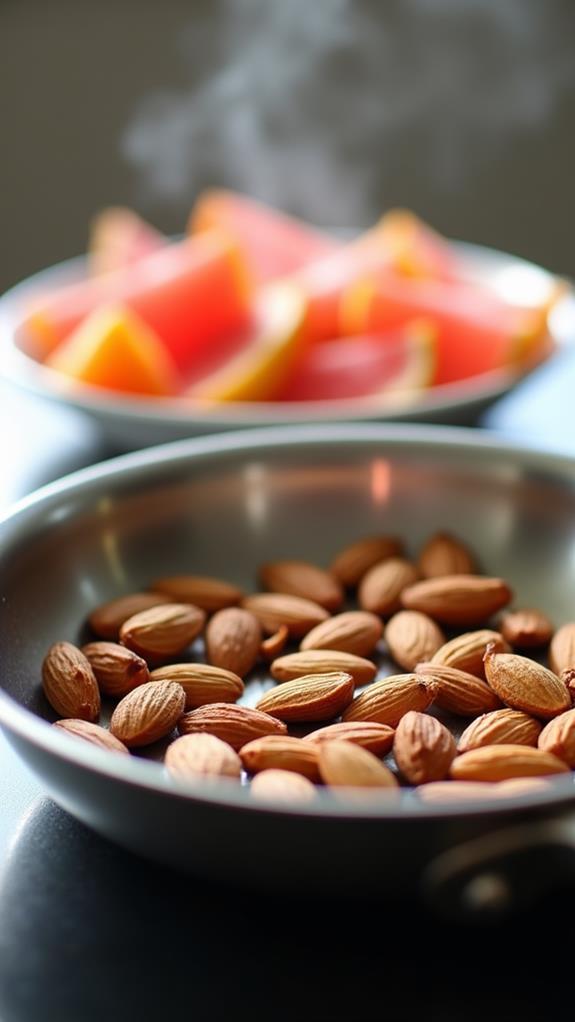
The final touch for your Winter Citrus Salad involves toasting and adding the sliced almonds. To begin, place a dry skillet over medium heat on your stovetop.
Once the pan is hot, add the 1/4 cup of sliced almonds. Keep a close eye on them, as they'll toast quickly. Gently shake the pan or stir the almonds with a wooden spoon to ensure even browning.
You'll know they're ready when they turn a golden color and release a nutty aroma, which should take about 3-5 minutes. Remove the toasted almonds from the heat immediately to prevent burning.
Let them cool for a minute or two before sprinkling them over your arranged citrus slices. The warm, toasted almonds will provide a delightful contrast to the cool, juicy fruit.
They'll add a satisfying crunch and a rich, nutty flavor that complements the bright, tangy citrus. For the best texture and presentation, add the almonds just before serving to maintain their crispness.
This final step elevates your Winter Citrus Salad from a simple fruit dish to an elegant, restaurant-worthy creation.
Step 5. Garnish With Fresh Mint

As a finishing touch, fresh mint leaves will add a pop of color and a refreshing aroma to your Winter Citrus Salad. To incorporate this vibrant herb, start by selecting a small bunch of fresh mint from your garden or local grocery store.
Gently wash the leaves under cool running water, then pat them dry with a clean kitchen towel or paper towels.
Once your mint is clean and dry, you'll want to chiffonade the leaves. This technique involves stacking several mint leaves, rolling them tightly, and then slicing them into thin ribbons. To do this, place 5-6 mint leaves on top of each other, roll them up lengthwise, and use a sharp knife to cut across the roll, creating delicate strips.
Sprinkle these mint ribbons evenly over your arranged citrus slices, allowing them to settle naturally on the fruit and between the toasted almonds.
The bright green color of the mint will contrast beautifully with the oranges and grapefruits, while its cool, fresh flavor will complement the sweet and tangy notes of the citrus.
Don't overdo it; a light scattering is all you need to elevate your salad's visual appeal and taste profile.
Final Thoughts
Bringing a burst of sunshine to your winter table, this citrus salad is a delightful way to enjoy seasonal fruits. You'll find it's not only visually appealing but also packed with essential nutrients, making it a healthy addition to your meals.
Don't hesitate to experiment with different citrus varieties, as each will bring its unique flavor profile to the dish. Remember, the key to a perfect citrus salad lies in the balance of sweet and tangy notes, which you can adjust by choosing your fruits carefully.
As you prepare this salad, you'll appreciate its versatility. It's equally at home as a light lunch, a refreshing side dish, or even a palate-cleansing dessert.
The combination of juicy citrus, crunchy almonds, and the honey-olive oil dressing creates a harmonious blend of textures and flavors that will enliven your taste buds. By mastering this simple yet elegant recipe, you'll have a go-to dish that's sure to impress guests and family alike, brightening up even the dreariest winter day with its vibrant colors and invigorating taste.

